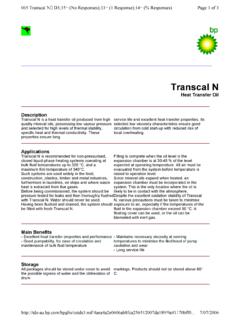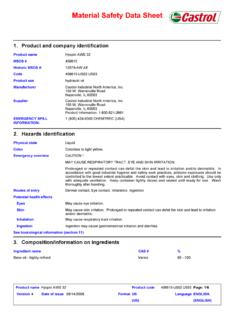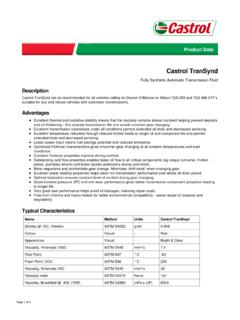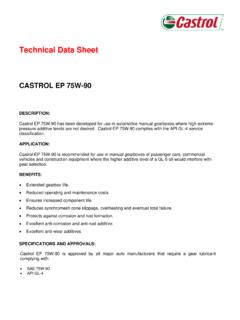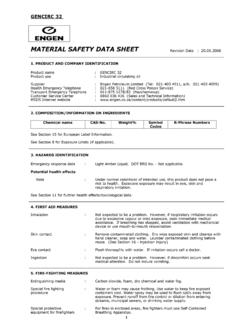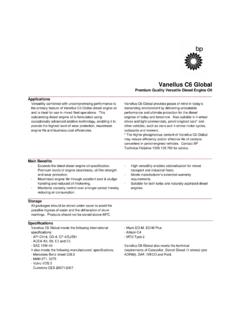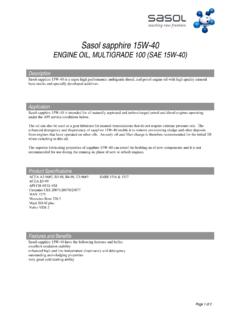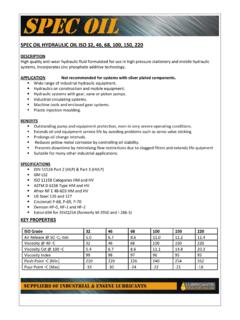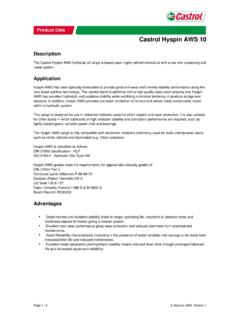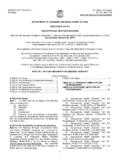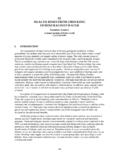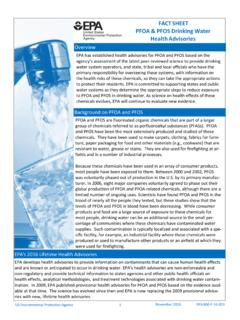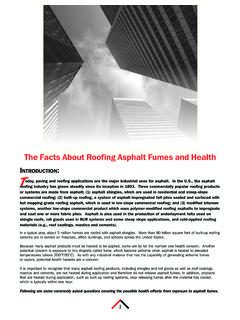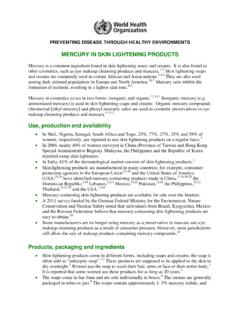Transcription of MATERIAL SAFETY DATA SHEET - Lubricants Online
1 ENGEN TQH 20/68 1 MATERIAL SAFETY data SHEETR evision Date : 1. PRODUCT AND COMPANY IDENTIFICATION Product name : ENGEN TQH 20/68 Product use : Hydraulic oil Supplier : Engen Petroleum Limited (Tel: 021-403 4911, a/h: 021-403 4099) Health Emergency Telephone : 021-658 5111 (Red Cross Poison Service) Transport Emergency Telephone : 011-975 1278/83 (Hazchemwise) Customer Service Center : 0860 036 436 (Sales and Technical Information) MSDS Internet website : 2. COMPOSITION/INFORMATION ON INGREDIENTS Chemical Numbers See Section 15 for European Label Information. See Section 8 for Exposure Limits (if applicable). 3. HAZARDS IDENTIFICATION Emergency response data : Amber Liquid. DOT ERG No. - Not applicable. Potential health effects Note : Under normal conditions of intended use, this product does not pose arisk to health. Excessive exposure may result in eye, skin andrespiratory irritation. See Section 11 for further health effects/toxicological data .
2 4. FIRST AID MEASURES Inhalation : Not expected to be a problem. However, if respiratory irritation occursdue to excessive vapour or mist exposure, seek immediate medicalassistance. If breathing has stopped, assist ventilation with mechanicaldevice or use mouth-to-mouth resuscitation. Skin contact : Remove contaminated clothing. Dry wipe exposed skin and cleanse withhand cleaner, soap and water. Launder contaminated clothing beforereuse. (See Section 16 - Injection Injury) Eye contact : Flush thoroughly with water. If irritation occurs call a doctor. Ingestion : Not expected to be a problem. However, if discomfort occurs seekmedical attention. Do not induce vomiting. 5. FIRE-FIGHTING MEASURES Extinguishing media : Carbon dioxide, foam, dry chemical and water fog. Special fire fightingprocedure : Water or foam may cause frothing. Use water to keep fire exposedcontainers cool. Water spray may be used to flush spills away fromexposure.
3 Prevent runoff from fire control or dilution from enteringstreams, municipal sewers, or drinking water supply. Special protectiveequipment for firefighters : For fires in enclosed areas, fire fighters must use Self-ContainedBreathing Apparatus. ENGEN TQH 20/68 2 Unusual fire and explosivehazards : None. Products of decomposition : Fumes, smoke, carbon monoxide, sulphur oxides, aldehydes and otherdecomposition products, in the case of incomplete combustion. Flash Point : 215 C (ASTM D-92)Upper Explosion Limit : %(V) Lower Eplosion Limit : %(V) NFPA Hazard Id : Health: 0; Flammability: 1; Reactivity: 0 6. ACCIDENTAL RELEASE MEASURES Procedure if MATERIAL isreleased or spilled : Report spills/releases as required to appropriate authorities. Methods for cleaning up : LAND SPILL: Shut off source taking normal SAFETY precautions. Takemeasures to minimize the effects on ground water. Recover by pumpingusing explosion-proof equipment or contain spilled liquid with sand orother suitable absorbent and remove mechanically into containers.
4 Ifnecessary, dispose of absorbed residues as directed in Section 13. WATER SPILL: Notify port and relevant authorities. Confine with boomsif skimming equipment is available to recover the spill for later recyclingor disposal. Warn other ships in the vicinity. If allowed by regulatory authorities theuse of suitable dispersants should be considered where recommended inlocal oil spill procedures. Personal precautions : See Section 8. Environmental precautions : Prevent spill from entering municipal sewers, water sources or low lyingareas. Advise the relevant authorities if contaminations have occurred. 7. HANDLING AND STORAGE Safe handling advice : No special precautions are necessary beyond normal good hygienepractices. Storage information : Keep containers closed when not in use. Do not store in open orunlabelled containers. Do not store near heat sources, sparks, flames,strong oxidizing agents and combustible materials. Storage and handlingprocedures : Prevent small spills and leakages to avoid slip hazard.
5 8. EXPOSURE CONTROLS / PERSONAL PROTECTION Occupational Exposure Limits (OELs) LTEL: Long Term Exposure Limits - Time Weight Average (TWA) over 8 hours. STEL: Short Term Exposure Limits - Time Weight Average (TWA) over 15 Minutes Note: Limits Shown for guidance only. Follow applicable regulations. Personal Protection Equipment (PPE) Engineering controls : If mists are generated, use ventilation, local exhaust or enclosures tocontrol below exposure limits. Respiratory protection : Approved respiratory equipment must be used when mist concentrationsexceed the recommended exposure limits. Eye protection : If splash with liquid is possible, chemical type goggles should be worn. Skin and body protection : No special equipment required. However, if frequent splashing or liquidENGEN TQH 20/68 3 contact is likely to occur, wear oil impervious gloves and clothing. Goodpersonal hygiene practices should always be followed. 9. PHYSICAL AND CHEMICAL PROPERTIES Appearance : Liquid.
6 Colour : Amber Odour : Mild Solubility : Negligible Boiling point/range : > 316 C Flash Point : 215 C (ASTM D-92) Vapour pressure : < hPa Density : g/cm3 @ 20 C (ASTM D-4052) Pour point : -12 C Viscosity, kinematic : mm2/s @ 40 C (ASTM D-445) mm2/s @ 100 C (ASTM D-445) 10. STABILITY AND REACTIVITY Stability : Stable. Conditions to avoid :Extreme heat and high energy sources of ignition, such as sparks andstatic electricity. Materials to avoid : Strong oxidizers. Hazardous decompositionproducts : Fumes, smoke, carbon monoxide, sulphur oxides, aldehydes and otherdecomposition products, in the case of incomplete combustion. 11. TOXICOLOGICAL INFORMATION Acute oral toxicity : (Rats): Practically non-toxic (LD50: Greater than 2000 mg/kg). Basedon testing of similar products and/or components. Acute inhalation toxicity : (Rats): Practically non-toxic (LC50: greater than 5mg/l). Based ontesting of similar products and/or the components.
7 Acute dermal toxicity : (Rabbits): Practically non-toxic (LD50: greater than 2000 mg/kg). Based on testing of similar products and/or the components. Skin irritation : (Rabbits): Practically non-irritating. (Primary Irritation Index: greaterthan but less than 3). Based on testing of similar products and/orthe components. Eye irritation : (Rabbits): Practically non-irritating. (Draize score: greater than 6 but15 or less). Based on testing of similar products and/or the components. Other acute toxicity data : Although an acute inhalation study was not performed with this product,a variety of mineral and synthetic oils, such as those in this product,have been tested. These samples had virtually no effect other than anonspecific inflammatory response in the lung to the aerosolized mineraloil. The presence of additives in other tested formulations (inapproximately the same amounts as in the present formulation) did notalter the observed effects.
8 Overexposure to oil mist may result in oildroplet deposition and/or granuloma formation. Sensitization : Not expected to be sensitizing based on tests of this product,components, or similar products. Repeated dose toxicity : No significant adverse effects were found in studies using repeateddermal applications of similar formulations to the skin of laboratoryanimals for 13 weeks at doses significantly higher than those expectedduring normal industrial exposure. The animals were evaluatedextensively for effects of exposure (haematology, serum chemistry,urinalysis, organ weights, microscopic examination of tissues etc.). Repeated and/or prolonged exposure may cause irritation to the skin,eyes or respiratory tract. ENGEN TQH 20/68 4 Teratogenicity : No teratogenic effects would be expected from dermal exposure, basedon laboratory developmental toxicity studies of major components in thisformulation and/or materials of similar composition. Carcinogenicity : Chronic mouse skin painting studies of severely solvent refined mineralbase oils showed no evidence of carcinogenic effects.
9 Synthetic base oilshave been tested in the Ames assay and other tests of mutagenicity withnegative results. These base oils are not expected to be carcinogenicwith chronic dermal exposures. 12. ECOLOGICAL INFORMATION Elimination information (persistence and degradability) Biodegradability : This product is expected to be inherently biodegradable. Physico-chemicalremovability : Adsorption to sediment and soil will be the predominant behaviour. Bioaccumulation : Minimal owing to low water solubility. Ecotoxicity effects Toxicity to aquaticorganisms : This substance is practically non-toxic to aquatic organisms (LL50: >1000 mg/l). Further information on ecology Remarks : In the absence of specific environmental data for this product, thisassessment is based on information for representative substances. 13. DISPOSAL CONSIDERATIONS Waste disposal : Product is suitable for burning in an enclosed, controlled burner for fuelvalue or disposal by supervised incineration.
10 Such burning may belimited pursuant to the Resource Conservation and Recovery Act. Inaddition, the product is suitable for processing by an approved recyclingfacility or can be disposed of at any government approved waste disposalfacility. Use of these methods is subject to user compliance withapplicable laws and regulations and considerations of productcharacteristics at time of disposal. Contaminated packaging : Empty containers retain residue (liquid and/or vapour) and can bedangerous. DO NOT PRESSURIZE, CUT, WELD, BRAZE, SOLDER, DRILL,GRIND OR EXPOSE SUCH CONTAINERS TO HEAT, FLAME, SPARKS,STATIC ELECTRICITY, OR OTHER SOURCES OF IGNITION; THEY MAY EXPLODE AND CAUSE INJURY OR DEATH. Do not attempt to refill orclean container since residue is difficult to remove. Empty drums shouldbe completely drained, properly bunged and promptly returned to a drumreconditioner. All containers should be disposed of in an environmentallysafe manner and in accordance with governmental regulations.
